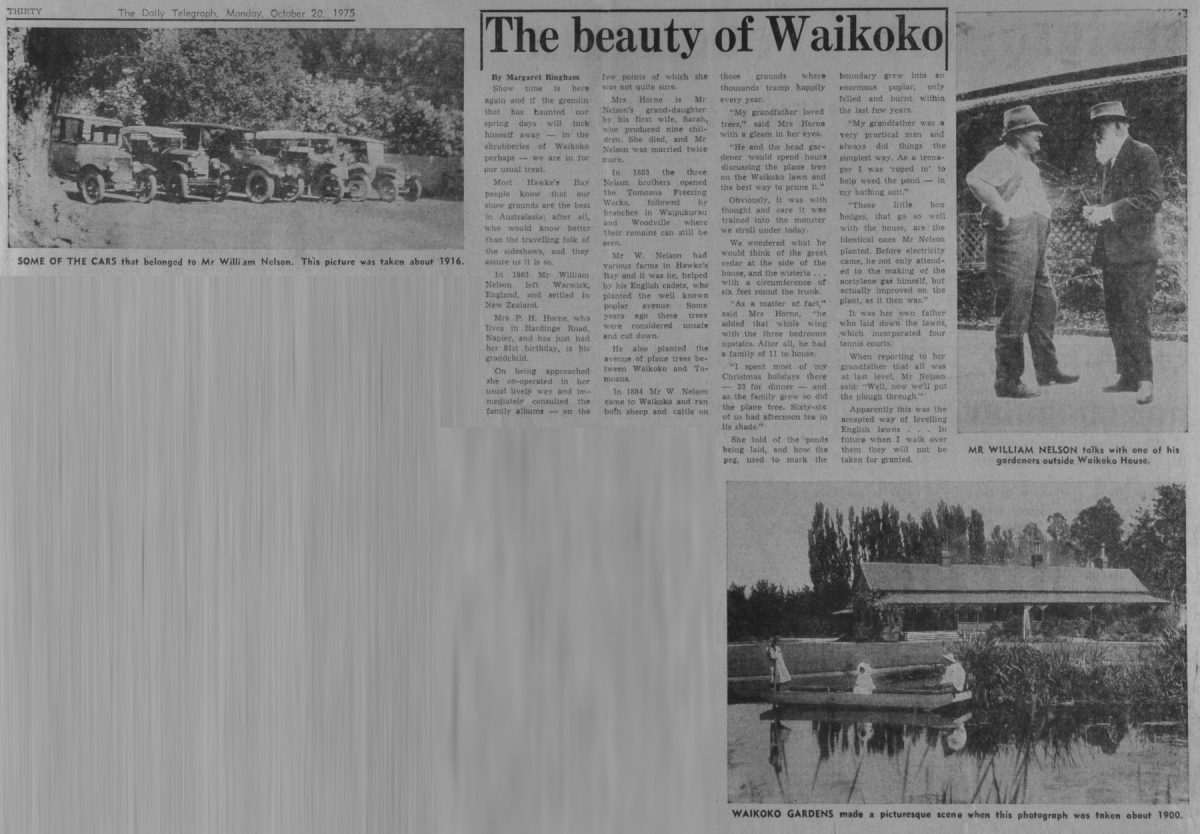THIRTY The Daily Telegraph, Monday, October 20, 1975
The beauty of Waikoko
By Margaret Bingham
Show time is here again and if the gremlin that has haunted our spring days will tuck himself away – in the shrubberies of Waikoko perhaps – we are in for our usual treat.
Most Hawke’s Bay people know that our show grounds are the best in Australasia; after all, who would know better than the travelling folk of the sideshows, and they assure us it is so.
In 1963 [1863] Mr William Nelson left Warwick, England, and settled in New Zealand.
Mrs P. H. [H.P.] Horne who lives in Hardinge Road, Napier, and has just had her 81st birthday, is his grandchild.
On being approached she co-operated in her usual lively way and immediately consulted the family albums – on the few points of which she was not quite sure.
Mrs Horne is Mr Nelson’s grand-daughter by his first wife, Sarah, who produced nine children. She died, and Mr Nelson was married twice more.
In 1883 the three Nelson brothers opened the Tomoana Freezing Works, followed by branches in Waipukurau and Woodville where their remains can still be seen.
Mr W. Nelson had various farms in Hawke’s Bay and it was he, helped by his English cadets, who planted the well known poplar avenue. Some years ago these trees were considered unsafe and cut down.
He also planted the avenue of plane trees between Waikoko and Tomoana.
In 1884 Mr W. Nelson came to Waikoko and ran both sheep and cattle on those grounds where thousands tramp happily every year.
“My grandfather loved trees,” said Mrs Horne with a gleam in her eyes.
“He and the head gardener would spend hours discussing the plane tree on the Waikoko lawn and the best way to prune it.”
Obviously, it was with thought and care it was trained into the monster we stroll under today.
We wondered what he would think of the great cedar at the side of the house, and the wisteria . . . with a circumference of six feet round the trunk.
“As a matter of fact,” said Mrs Horne, “he added that whole wing with the three bedrooms upstairs. After all, he had a family of 11 to house.
“I spent most of my Christmas holidays there – 23 for dinner – and as the family grew so did the plane tree. Sixty-six of us had afternoon tea in its shade.”
She told of the ponds being laid, and how the peg, used to mark the boundary grew into an enormous poplar, only felled and burnt within the last few years.
“My grandfather was a very practical man and always did things the simplest way. As a teenager I was ‘roped in’ to help weed the pond – in my bathing suit.”
“Those little box hedges, that go so well with the house, are the identical ones Mr Nelson planted. Before electricity came, he not only attended to the making of the acetylene gas himself, but actually improved on the plant, as it then was.”
It was her own father who laid down the lawns, which incorporated four tennis courts.
When reporting to her grandfather that all was at last level, Mr Nelson said: “Well, now we’ll put the plough through.”
Apparently this was the accepted way of levelling English lawns . . . In future when I walk over them they will not be taken for granted.
Photo captions –
SOME OF THE CARS that belonged to William Nelson. This picture was taken about 1916.
MR WILLIAM NELSON talks with one of his gardeners outside Waikoko House.
WAIKOKO GARDENS made a picturesque scene when this photograph was taken about 1900.












Do you know something about this record?
Please note we cannot verify the accuracy of any information posted by the community.